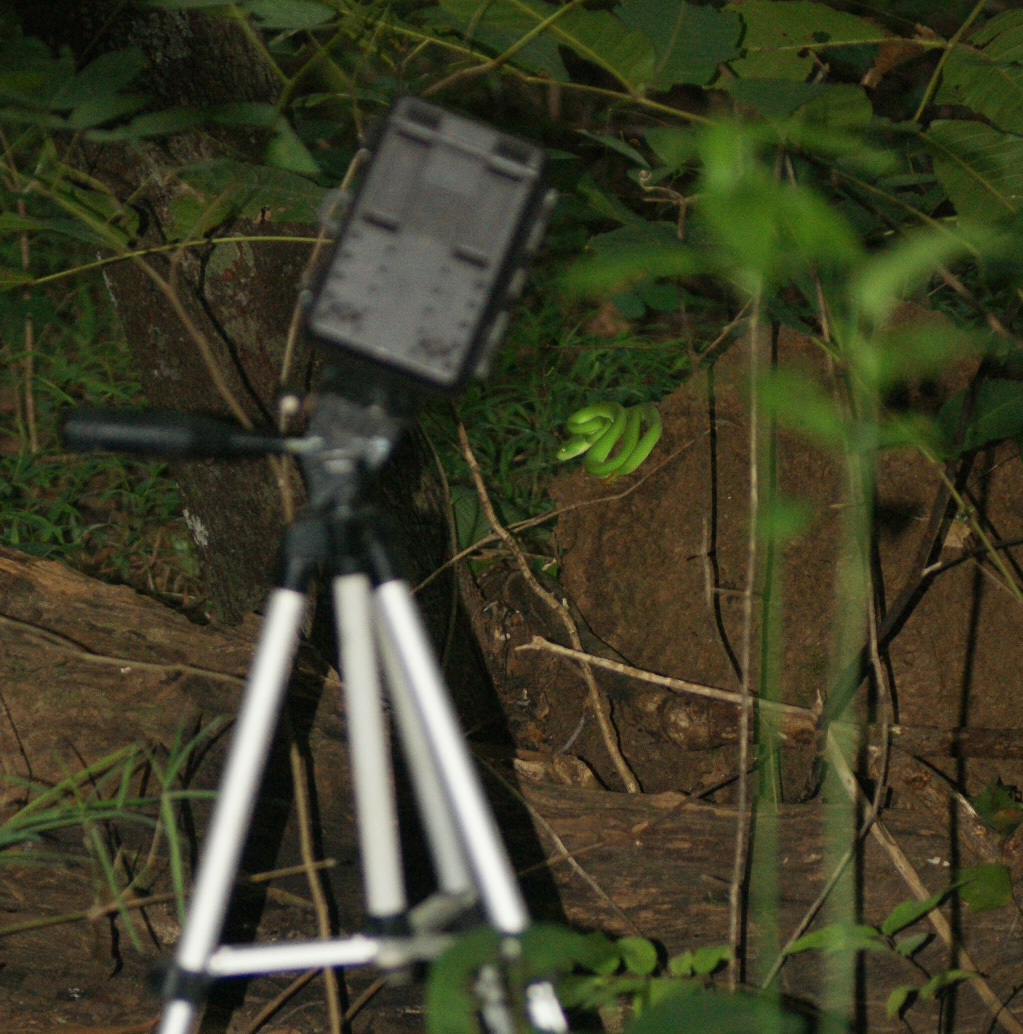Social Behavior Displayed by the Green Pit Viper Trimeresurus (Cryptelytrops) macrops
DOI:
https://doi.org/10.58837/tnh.20.1.178323References
Brattstrom, B.H. 1974. The evolution of reptilian social behavior. American Journal of Zoology, 14: 35-49.
Bonnet, X., Shine, R., and Lourdais, O. 2002. Taxonomic chauvinism. Trends in Ecology and Evolution, 17: 1-3.
Pawar, S. 2003. Taxonomic chauvinism and the methodological challenged. Bioscience, 53: 861-864.
Ford, N. 1995. Experimental design in studies of snake behavior. Herpetological Monographs, 9: 130-139.
Schuett, G.W., Clark, R.W., Repp, R.A., Amarello, M., Smith, C.F., and Greene, H.W. 2017. Social behavior of rattlesnakes: a shifting paradigm. In: Schuett, G.W., Feldner, M.J., Smith, C.F., and Reiserer, R.S. (eds.). Rattlesnakes of Arizona, vol. 2. Eco Publishing, Rodeo, NM, USA. p. 161-244.
Caro, T. 1999. The behavior-conservation interface. Trends in Ecology and Evolution, 14(9): 366-369.
Burghardt, G. M., Chiszar, D., Murphy, J.B., Romano Jr., J., Walsh, T., and Manrod, J. 2002. Behavioral complexity, behavioral development and play. In: Murphy, J.B, Ciofi, C., de La Panouse, C., and Walsh, T. (eds.). Komodo Dragons: Biology and Conservation. Smithsonian Institution Press, Washington, D. C., USA. p. 78-117.
Doody, J.S., Burghardt, G.M., and Dinets, V. 2013. Breaking the social–non-social dichotomy: a role for reptiles in vertebrate social behavior research? Ethology, 199:1-9.
Nowak, E.M., Theimer, T.C., and Schuett, G.W. 2008. Functional and numerical responses of predators: where do vipers fit in the traditional paradigms? Biological Review, 83: 601-620.
Clark, R.W. 2016. The hunting and feeding behavior of wild rattlesnakes. In: Schuett, G.W., Feldner, M.J., and Smith, C.F. (eds.). The Rattlesnakes of Arizona. Eco Publishing, Rodeo, NM, USA. p. 91-118.
Dorcas, M.E., and Willson, J.D. 2009. Innovative methods for studies of snake ecology and conservation. Snakes: ecology and conservation, p. 5-37.
Barnes, C.H., Strine, C.T., Suwanwaree, P., and Hill III, Jacques. 2017. Movement and home range of green pit vipers (Trimeresurus spp.) in a rural landscape in Northeast Thailand. Herpetological Bulletin, 142: 19-28.
Gillingham, J.C. 1987. Social behavior. In: Seigel, R.A., Collins, J.T., and Novak, S.S. (eds.). Snakes: Ecology and Evolutionary Biology. MacMillan Publishing Company, New York, USA. p. 184-209.
Kramer, E. 1977. Zur Schlangenfauna Nepals. Revue suisse Zoologie, 84: 721-761.
Strine, C., Silva, I., Nadolski, B., Crane, M., Barnes, C., Artchawakom, T., Hill, J., and Suwanwaree, P. 2015. Sexual dimorphism of tropical Green Pit Viper Trimeresurus (Cryptelytrops) macrops in Northeast Thailand. Amphibia-Reptilia, 36: 1-12.
Wilkinson, S.L. 2014. Guide to venomous reptiles in veterinary practice. Journal of Exotic Pet Medicine, 23: 337-346.
Reinert, H.K., and Cundall, D. 1982. An improved surgical implantation method for radio-tracking snakes. Copeia, 1982: 702-705.
Hardy, D.L. and Greene, H.W. 2000. Inhalation of anesthesia of rattlesnakes in the field for processing and transmitter implantation. Sonoran Herpetology, 13: 109-113.
Strine, C., Silva, I., Barnes, C.H., Marshall, B.M., Artchawakom, T., Hill III, J., and Suwanwaree, P. 2018. Spatial ecology of a small arboreal ambush predator, Trimeresurus macrops Kramer, 1977, in Northeast Thailand. Amphibia- Reptilia, 39: 335-345.
Maritz, B., and Alexander, G.J. 2012. Dwarfs on the move: spatial ecology of the world's smallest viper, Bitis schneideri. Copeia, 1: 115-120.
Sawant, Nitin S. and Jadhav, T.D. 2012. Factors influencing habitat selection by arboreal pit vipers. Zoological Science, 30: 21-26.
Reza, Fachrul. 2018. Keanekaragaman ular pitviper Sumatera (Serpentes: Viperidae: Crotalinae) berdasarkan ketinggian di Sumatera barat. Journal of Tropical Biodiversity and Biotechnology, 3: 49-56.
Cox, R.M., Butler, M.A., and John-Alder, H.B. 2007. The evolution of sexual size dimorphism in reptiles. In: Sex, Size and Gender Roles: Evolutionary Studies of Sexual Size Dimorphism, p. 38-49. Fairbairn, D.J., Blanckenhorn, W.U., and Szekely, T., Eds, Oxford University Press, London.
Chanhome, L., Cox, M. J. Vararuchapong, T. Chaiyabutr, N. and Sitprija, V. 2011. Characterization of venomous snakes of Thailand. Asian Biomedicine, 5: 311-328.
Strine, C., Brown, A., Barnes, C.H., Major, T., Artchawakom, T., Hill III, J.G., and Suwanwaree, P. 2018. The first record of arboreal male to male combat of free ranging big-eyed green pit vipers (Trimeresurus macrops) in Northeast Thailand. Current Herpetology, 37(1): 81-87.
Schoener, T.W. 1983. Simple models of optimal feeding- territory size: A reconciliation. The American Naturalist, 121: 608-629.
Grant, J.W.A. 1993. Whether or not to defend? The influence of resource distribution. Marine Behaviour and Physiology, 23: 137-153.
Dubois, F., and L.A. Giraldeau. 2005. Fighting for resources: The economics of defense and appropriation. Ecology, 86: 3-11.
Brown, J.L., and G.H. Orians. 1970. Spacing patterns in mobile animals. Annual Review of Ecology and Systematics, 1: 239-262.
Greene, H.W. 1997. Snakes: The evolution of mystery in nature. Berkeley, CA: University of California Press.
Huang, W.S., H.W. Greene, T.J. Chang, and Shine, R. 2011. Territorial behavior in Taiwanese kukrisnakes (Oligodon formosanus). Proceedings of National Academy of Sciences, 108: 7455-7459.
Mori, A., Ota, H., and Hirate, K. 2019. Defending resources on isolated islands. p. 288-309. In: H. B. Lillywhite and M. Martins. Islands and Snakes. Isolation and Adaptive Evolution. Oxford University Press, New York.
Orlov, N., Ananjeva, N., and Khalikov, R. 2002. Natural history of pitvipers in Eastern and Southeastern Asia. In: Schuett, G., Hoggren, W.M., Douglas, M.E., and Green, H.W. (eds.). Biology of the Vipers. Eagle Mountain Publishing, Eagle Mountain, Utah, USA. p. 345-361.
Wittenberg, R.D. 2012. Foraging ecology of the timber rattlesnake (Crotalus horridus) in a fragmented landscape. Herpetological Conservation and Biology, 7: 449-461.
Greene, H.W. 2013. Tracks and Shadows. Field Biology as Art. University of California Press, Berkeley and Los Angeles, USA.
Lillywhite, H.B. 2014. How Snakes Work. Structure, Function and Behavior of the World’s Snakes. Oxford University Press, New York, USA.
Lin, H.C., Hung, H.Y., Lue, K.Y., and Tu, M.C. 2007. Diurnal retreat site selection by the arboreal Chinese green tree viper (Trimeresurus s. stejnegeri) as influenced by temperature. Zoological Studies, 46: 216-2.

Downloads
Published
How to Cite
Issue
Section
License
Chulalongkorn University. All rights reserved. No part of this publication may be reproduced, translated, stored in a retrieval system, or transmitted in any form or by any means, electronic, mechanical, photocopying, recording or otherwise, without prior written permission of the publisher











